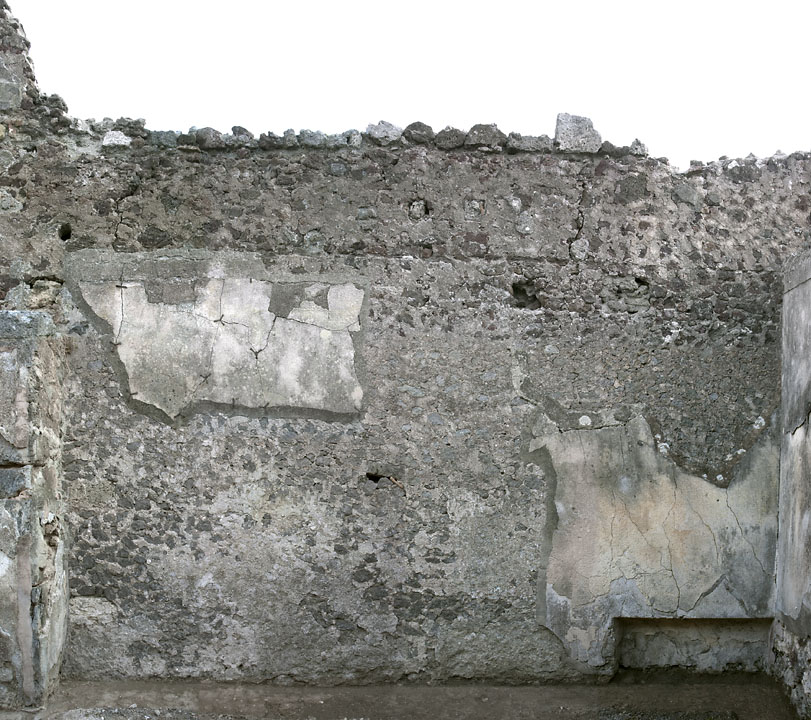East Wall
Description
Renée Forsell
This is the oldest wall of the house. The wall is built in op. incertum and consists almost entirely, except for two limestone blocks in the N corner, of lava up to the height of 3.10. Above 3.10m the material is cruma. There are no spolia. The stones are set in a red mortar tempered with small pieces of lava and terracotta. Much mortar is covering the stones. There are some cracks in the upper part of the wall.
There are six beam-holes, with a distance of c. 0.4m between them, in the upper middle part of the wall. They are placed as forming a vault. The holes were walled up in antiquity, filled with grey mortar, stones and some pieces of terracotta. The northernmost beam hole is situated c. 2.1m from the N corner and the southernmost c. 1.7m from the S corner at a height of 3.70-4.15m. The lowermost holes are places just above a horizontal cavity, running the whole length of the wall, marking where a cornice would have been set. Another hole is visible in the wall 4,90m from the N corner at a height of 3.30-3.70m. This square hole was filled with limestone and light grey mortar. To the N of it yet another square hole is located at about the same height. It may be ancient or be the result of stones that has fallen out of the wall. In the S corner there is a rectangular niche. The upper part of the niche is gently sloping until its reaches its full depth at floor level.
There are two large patches of plaster left on the wall. One is located at the upper N part of the wall c. 0.10-2.50 m from the N corner at the height of c. 2.35-2.50. Modern mortar encircles it and it is also held in place by iron clamps. The plaster is weathered but seems to have had a yellow colour and there are vague traces of two parallel, engraved lines marking the edge of a horizontal decorative band. The other patch of plaster is located in the lower S corner at the height of 0.55-2.55m. It is c. 2.0m wide and supported by modern mortar. This patch is also badly worn but traces of yellow finish can be distinguished. In the middle and upper part there are parallel, engraved lines in the plaster, the remains of decorative bands. There are also engravings of a vertical, band. The lines cross each other at the height of c. 2.160 and 2.165. Finally there is a vertical line, 1.80m long, running 3.5cm from the S corner. This indicates that the southernmost panel would have been c. 1,155m wide. There are also fragments of plaster coating on the lower part of the wall.
Almost the entire niche is covered by plaster. In the S corner and along the floor there are remains of black bands. Also the upper part has minor traces of black. There is modern plaster in a small area in the middle of the niche, and to some extent also on the S side. The N side is covered with modern mortar.
Wall l. 6.31; h. max 5.11, min 4.85
The six holes N to S
1: 2.10 fr. N corner at h. of 3.70-3.90m
2: 2.50 fr. N corner at h. of 3.90-4.10m
3: 2.95 fr. N corner at h. of 4.10-4.30m
4: 3.35 fr. N corner at h. of 4.15-4.35m
5: 3.90 fr. N corner at h. of 4.00-4.20m
6: 4.40 fr. N corner at h. of 3.75-3.90m
Niche c. 0.62-0.64 high, c. 1.45 wide, 0.18-0.19 deep

